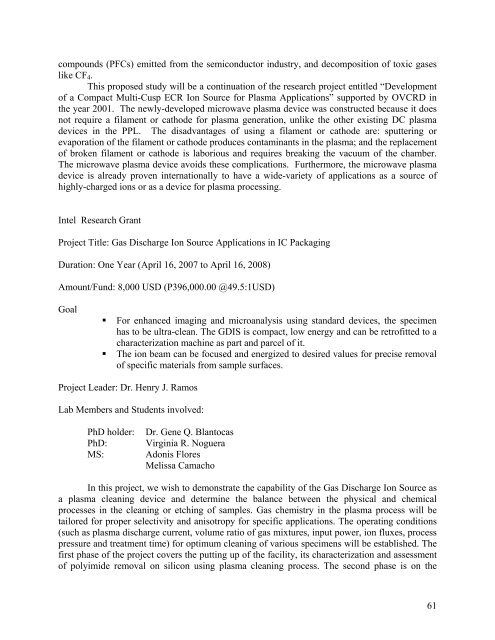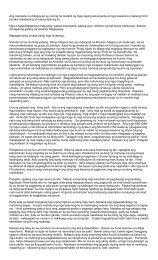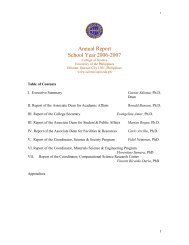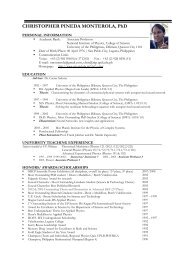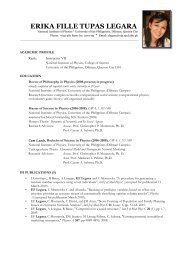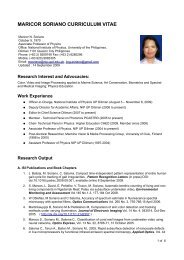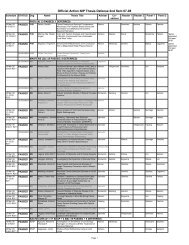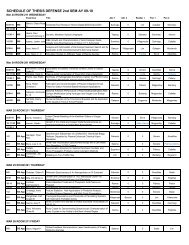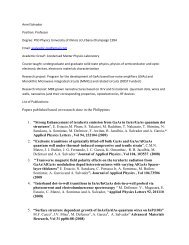NIP REPORT January 2006- May 2007 - The UP College of Science ...
NIP REPORT January 2006- May 2007 - The UP College of Science ...
NIP REPORT January 2006- May 2007 - The UP College of Science ...
You also want an ePaper? Increase the reach of your titles
YUMPU automatically turns print PDFs into web optimized ePapers that Google loves.
compounds (PFCs) emitted from the semiconductor industry, and decomposition <strong>of</strong> toxic gases<br />
like CF4.<br />
This proposed study will be a continuation <strong>of</strong> the research project entitled “Development<br />
<strong>of</strong> a Compact Multi-Cusp ECR Ion Source for Plasma Applications” supported by OVCRD in<br />
the year 2001. <strong>The</strong> newly-developed microwave plasma device was constructed because it does<br />
not require a filament or cathode for plasma generation, unlike the other existing DC plasma<br />
devices in the PPL. <strong>The</strong> disadvantages <strong>of</strong> using a filament or cathode are: sputtering or<br />
evaporation <strong>of</strong> the filament or cathode produces contaminants in the plasma; and the replacement<br />
<strong>of</strong> broken filament or cathode is laborious and requires breaking the vacuum <strong>of</strong> the chamber.<br />
<strong>The</strong> microwave plasma device avoids these complications. Furthermore, the microwave plasma<br />
device is already proven internationally to have a wide-variety <strong>of</strong> applications as a source <strong>of</strong><br />
highly-charged ions or as a device for plasma processing.<br />
Intel Research Grant<br />
Project Title: Gas Discharge Ion Source Applications in IC Packaging<br />
Duration: One Year (April 16, <strong>2007</strong> to April 16, 2008)<br />
Amount/Fund: 8,000 USD (P396,000.00 @49.5:1USD)<br />
Goal<br />
For enhanced imaging and microanalysis using standard devices, the specimen<br />
has to be ultra-clean. <strong>The</strong> GDIS is compact, low energy and can be retr<strong>of</strong>itted to a<br />
characterization machine as part and parcel <strong>of</strong> it.<br />
<strong>The</strong> ion beam can be focused and energized to desired values for precise removal<br />
<strong>of</strong> specific materials from sample surfaces.<br />
Project Leader: Dr. Henry J. Ramos<br />
Lab Members and Students involved:<br />
PhD holder: Dr. Gene Q. Blantocas<br />
PhD: Virginia R. Noguera<br />
MS: Adonis Flores<br />
Melissa Camacho<br />
In this project, we wish to demonstrate the capability <strong>of</strong> the Gas Discharge Ion Source as<br />
a plasma cleaning device and determine the balance between the physical and chemical<br />
processes in the cleaning or etching <strong>of</strong> samples. Gas chemistry in the plasma process will be<br />
tailored for proper selectivity and anisotropy for specific applications. <strong>The</strong> operating conditions<br />
(such as plasma discharge current, volume ratio <strong>of</strong> gas mixtures, input power, ion fluxes, process<br />
pressure and treatment time) for optimum cleaning <strong>of</strong> various specimens will be established. <strong>The</strong><br />
first phase <strong>of</strong> the project covers the putting up <strong>of</strong> the facility, its characterization and assessment<br />
<strong>of</strong> polyimide removal on silicon using plasma cleaning process. <strong>The</strong> second phase is on the<br />
61


